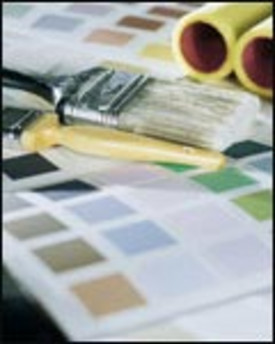Selecting the ideal sheen or gloss level for an interior or exterior paint job involves both aesthetic and practical considerations. From an aesthetic standpoint, sheen or gloss creates visual interest, particularly indoors. From a practical standpoint, the right sheen or gloss can help extend the life of the paint job, whether on an interior or exterior application.
Most brands of paint come in at least four sheen levels. Gloss paints, as the name implies, have the highest light-reflective characteristics. Then, in descending order of sheen, are semi-gloss paints; satin, eggshell, or low-luster paints; and flat paints. Both latex and oil-based paints are available in different sheen levels.
Interior Paint Selection Guide
 |
| Where traffic, moisture, and abrasion are likely to occur, high-gloss finishes may be recommended. Flat finishes and low-luster paints are better suited to quieter areas of the home and new construction. |
Gloss Paint
Gloss paints, often called high-gloss finishes, have a highly reflective appearance. They produce the toughest, most durable, and most stain-resistant finishes. They are easier to clean than less reflective or low-luster paints. So, they are ideal for areas exposed to heavy traffic or use, especially those prone to fingerprints or grime. Because of their highly selective appearance, however, gloss paints tend to highlight surface imperfections. As a result, if your walls or woodwork are marred or irregular, you might want to select paint with a lower sheen level. Both latex and oil-based gloss paints are referred to as enamels.
By way of comparison, latex enamels have several advantages: They dry more quickly, resist yellowing, and have better mildew resistance, making them ideal for bathrooms, kitchens, and laundry rooms. On the other hand, high-quality oil-based enamels are harder, have greater abrasion resistance and, in some cases, have a slightly higher gloss.
Semigloss Paint
Semigloss paints have a slightly glossy appearance and are less reflective than gloss paints. They offer good stain resistance, are easy to clean, and may be a good choice if you have young children. Must experts agree that the highest quality semigloss paints are 100% acrylic latex paints, which also come in enamel grades.
Satin, Eggshell, or Low Luster Paint
Regardless of the name, these paints have a sheen level that is lower than semigloss, yet more lustrous than flat paints. Satin and low luster paints have a slightly higher sheen than eggshell finishes. Paints in this category impart greater warmth and depth to surfaces than flat paints. They also resist stains better than flat paints, although not as well as semigloss and high-gloss finishes.
Flat Paint
Flat paints are non-reflective, so they tend to conceal surface imperfections better than paints with higher sheen levels. This finish is especially good for walls that are dented or rough. Likewise, flat paints are a good choice for ceilings, because of their low reflectivity.
Flat paints are invaluable when painting over new drywall where an unsanded tape job or porous joint compound has been used. In these cases, flat paints can help make the surfaces look smooth and uniform. For new construction, repair work, or anywhere unpainted drywall or joint compound is involved, an interior primer is recommended to provide a uniform appearance.
Keep in mind that stains can be difficult to remove from flat finishes. Unlike paints with higher sheen, their non-reflective surfaces have a porous texture, which can trap dirt and make cleaning difficult. So, it’s wise to use flat paints only in areas that do not tend to get soiled.
Credit: Renovate Your World




























